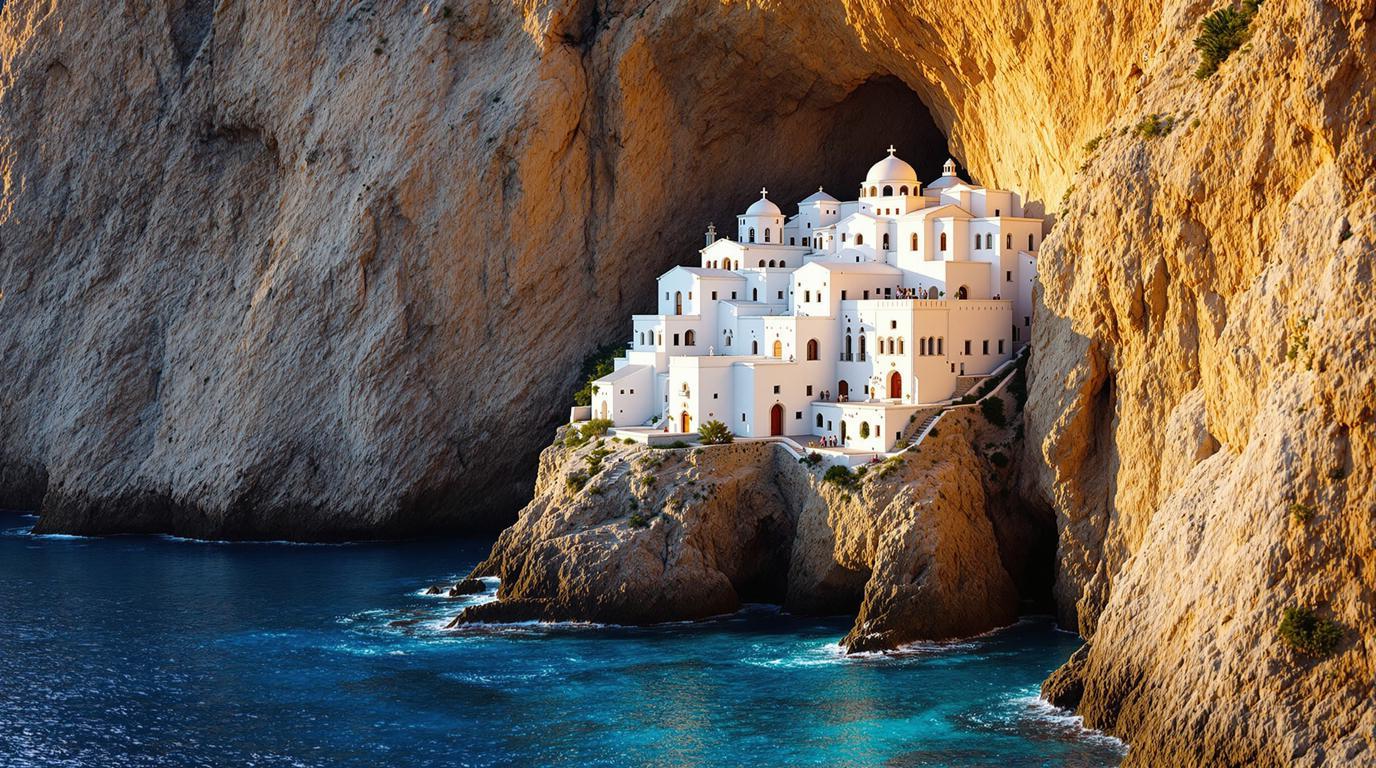Perched dramatically on Greece’s eastern Aegean edge, Amorgos stands as a defiant alternative to the Instagram-trampled islands that dominate travel feeds. This remote island captivates with its 300-meter cliffs plunging dramatically into electric-blue waters and a millennium-old monastery that seems impossibly fused with the vertical rock face. Unlike its flashier Cycladic siblings, Amorgos delivers raw, untamed beauty for travelers willing to venture beyond the obvious.
The monastery that defies gravity
The blindingly white Panagia Hozoviotissa Monastery clings to a sheer cliff 300 meters above crashing waves, appearing almost as a mirage against the dark rock. Built in the 11th century, this eight-story marvel houses just a handful of monks who maintain centuries-old traditions.
“Living here connects you to something eternal,” explains Father Nikolaos, who has called this vertical sanctuary home for three decades. “When visitors climb our 300 steps, they’re not just reaching a monastery—they’re ascending toward something transcendent.”
The monastery’s balcony offers heart-stopping views across the Aegean, rivaling Bavaria’s fairytale castles for dramatic positioning. Inside, centuries-old icons gleam in flickering candlelight while monks offer visitors traditional raki and sweet loukoumi.
Agia Anna: The beach that starred in “The Big Blue”
Directly beneath the monastery lies Agia Anna, a pebbled beach framed by towering cliffs made famous as a filming location for Luc Besson’s cult diving film “The Big Blue.” The startling clarity of its waters has become legendary among free divers and photographers.
What many visitors miss is the hidden sea cave at the beach’s northern edge, a natural tunnel reminiscent of Greece’s other remarkable coastal caves. Locals call it their “tunnel of love,” with sunlight filtering through cracks in the rock ceiling, creating an otherworldly blue glow.
Ancient pathways connecting forgotten villages
Amorgos harbors a network of ancient stone footpaths that predate modern roads by millennia. These trails connect whitewashed villages that seem frozen in time, offering hikers an authentic glimpse into traditional Cycladic life.
The island’s 50+ kilometers of marked trails make it a hiker’s paradise, similar to the extensive network found on other Greek islands with historic pathways. The route from Chora to Aegiali provides the most dramatic vistas, traversing windswept ridges with views extending across multiple islands.
Untouched beaches that require dedication
Reaching Amorgos’s most stunning beaches demands effort—a reality that has preserved their pristine condition. Mouros Beach features dramatic black rocks contrasting with turquoise waters, while Kalotaritissa offers golden sand and a shipwreck you can swim to.
“We don’t want escalators to our beaches like Santorini,” says Maria Despotidi, owner of a family taverna in Aegiali. “The journey here is part of the experience—it filters out those who just want a selfie.”
A culinary scene untouched by franchises
Amorgian cuisine remains refreshingly authentic, centered around locally-raised goat, hand-picked herbs, and fishing traditions dating back generations. The island’s signature dish, patatato (goat stewed with potatoes), appears on virtually every taverna menu, each family guarding their unique preparation.
For travelers seeking authenticity away from mass tourism, Amorgos offers a similar escape to other Greek islands preferred by locals over tourists. Here, dining companions are more likely to be Greek families than foreign visitors.
When to experience Amorgos’s dramatic contrasts
June and September offer the perfect balance: warm enough for swimming without the crushing August heat and crowds. Winter transforms the island dramatically, with fierce Aegean storms lashing the cliffs and monastery, creating a moody landscape photographers dream about.
Though reaching Amorgos requires more effort than jetting to Mykonos or Santorini (no airport means a ferry journey of 5-9 hours from Athens), this journey acts as a natural filter. Unlike Africa’s heavily-visited wildlife experiences, Amorgos offers something increasingly rare: a destination where authentic experiences still outweigh tourist traps.
